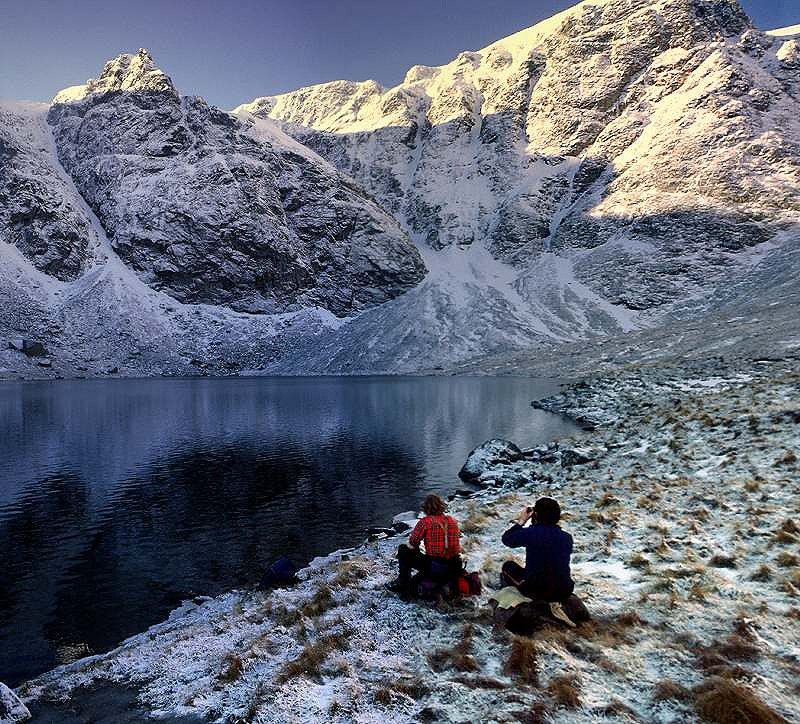
Robert Capa's iconic images of the American troops landing on Omaha Beach were wrongly processed (by Larry Adams), tilted, and full of camera shake and blur....but they worked! Why? Because content and substance are more important, and the images somehow captured the chaos and drama of what was happening. They demand our attention and time.
Greg Child put it somewhat more elegantly when he wrote...
"I once came across a photograph, of a sweeping panorama of one of the most rugged stretches of land on the planet....
The image, Panorama of the Baltoro Glacier 1909, showed a triumvirate of enormous mountains looming above a braid of winding, eerily striated glaciers. The leftmost was K2, which I knew to be the second tallest peak on earth....
The name of the photographer-Vittorio Sella was unfamiliar to me, and the panorama he had pieced together was even stranger, unlike any natural scene I had ever laid my eyes on.
I was riveted."
Greg Child
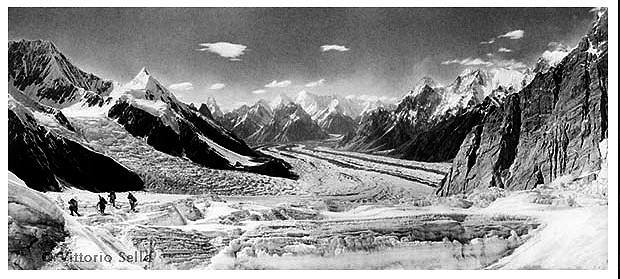
Somebody once said that photography is 10% perspiration and 90% inspiration, but with climbing photography, considering some of the remote locations and viewpoints, there might be as much perspiration. However, in this article, we are principally concerned with the aesthetic qualities pertaining to the photographic image. There is already much information on preparing and resizing images on the UKClimbing site. Most of the digital camera magazines proffer advice concerning the technical aspects relevant to achieving the best photographic image using software such as Photoshop, Elements and Paintshop Pro, the use of layers et al. Even the many comments received on the UKClimbing.com photography forum are chiefly concerned with technical aspects of photography, such as exposure, focus, pixilation, colour balance, levels, etc etc. However, where and how to progress when you know all this? You have the 10 megapixel DSLR complete with a selection of lenses, tripod, filters, all the relevant software, photo manuals, etc. But for ingredient X read on...
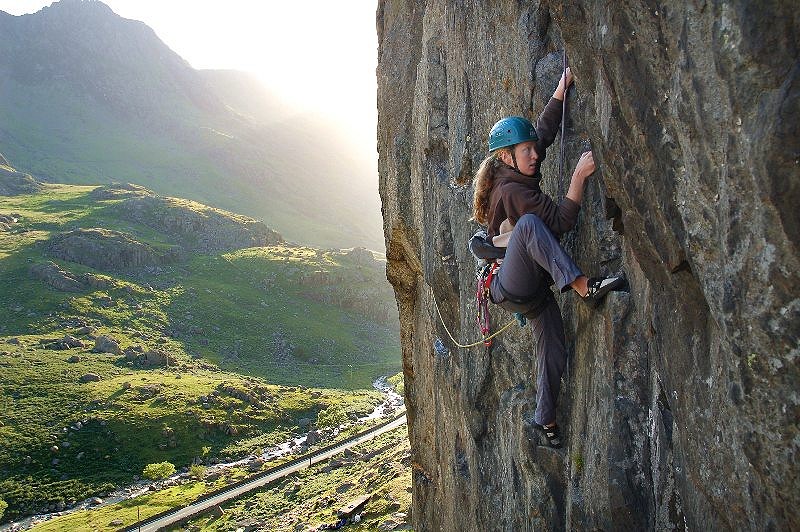
According to American photographer George Barr, there are seven levels by which the aesthetic can be evaluated in the photographic print:
1. Prints don't seem to have a point, and don't make good snapshots.
2. Decent snapshots.
3. Friends are admiring your 'snapshots.'
4. Prints starting to have artistic value for themselves.
5. Images are generally admirable and most photographers would react with "wish I had taken that picture." Composition is spot on, the subject interesting, and the presentation of the subject effective. The only thing missing is an emotional response to the image. You're inclined to say "Well done," rather than "Oh my God..,'" or "Wow." Possibly 'Photo of the Week' on UKC?
6. The images are very strong – they generate emotional responses. You might not mortgage the house to get one and they don't leave you weak-kneed but they are wonderful. Most of us would be delighted to get a handful of images a year into this category. Suitable as cover material for the best outdoor magazines.

7. They are the great images of history – the ones, that make you weep or cry out or swear. These are the handful of images so exceptional that even the best photographers in history have only been able to make a few at best. Here lies Ansel Adam's Storm clearing from Yosemite Valley. Vittoria Sella's Baltoro Panorama. Bradford Washburn's Grande Jorasse at Moonrise. Doug's Scott's image of Haston stepping onto the Summit of Everest as the sun sets (see below). Perhaps John Cleare's Cenotaph Corner. Familiarity breeds contempt they say, but the opposite applies with the very best photographic mountain art.
Therefore, where does that leave us? Everyone starts at level 1. The first decision then, are you climber or photographer? Which is more important? Then, how far to progress up this scale? Well that all depends upon such diverse factors as skill, time, ambition, artistic creativity, vision, and ultimately luck. i.e. being in the right place at the right time. In short, what is it that separates the Photographer from the Snapper? Composition and Design exert a major influence on such progress, and experience and knowledge is achieved by practice, and observation of the work of many varied and diverse photographers and artists. Hence the purpose of this article.
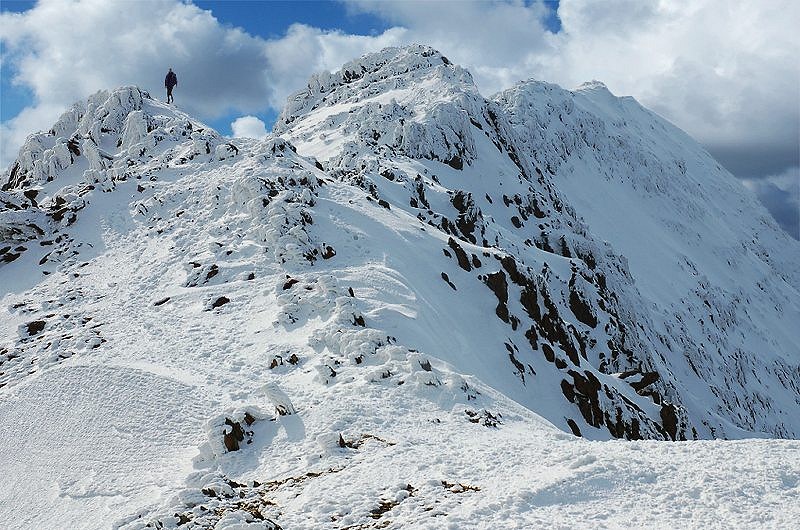
Two of the essential components within any good photograph are Composition and Design, but they are often ill considered, or not deemed especially relevant by many climbing photographers. Until it is, their photography will not advance. So what exactly is Composition and Design?
"The photographer has almost as much control over his subject matter as a painter. He can control light and shade, form and space, pattern and texture, motion and mood, everything except composition."
Andreas Feininger
Sorry Andreas but you are wrong. There is substantial control. The most elementary aid to better composition is cropping if nothing else.
It is primarily concerned with the arrangement and layout of the image within the rectangle of the page / screen, while Design is graphically concerned with those Elements that so describe that image.
COMPOSITION
Most of this is done when we look through the viewfinder and compose the picture but some adjustment can occur in the darkroom / on the screen. A tripod can be a beneficial aid towards improved composition. The experienced photographer will look carefully beforehand with both the mind and eye. This is visualisation.
DESIGN
The design elements are:
"I almost never set out to photograph a landscape, nor do I think of my camera as a means of recording a mountain or an animal unless I absolutely need a 'record shot'. My first thought is always of light."
Galen Rowell
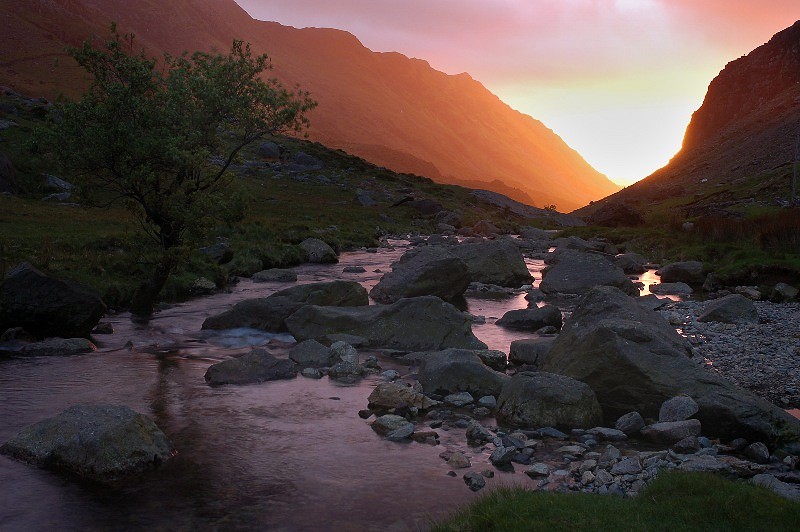
LIGHT
This is the overriding essential element required within photography (even at night), and the way in which that light is seen and exploited will combine one or more of these Elements. This involves conscious and subconscious decisions when the photograph is taken, defining that element which is the most assertive component within the design of the image. A slow shutter speed might enhance a landscape that has a fast-flowing stream in the foreground, but also provide an enhanced Depth of Field or suggest movement, or again embellish the mood within the photograph. If the light looks at all promising then get out with the camera.
"Ah, but you see Blackadder, my medium is light"
Lieutenant George to Blackadder when they are sent into No Man's Land by General Melchett, to paint a plan of the German trenches...at night!
CROPPING AND EDITING THE IMAGE
Cropping occurs twice in the workflow process, initially when viewing the image in the viewfinder, and the first processing action in any editing software. With the camera on a tripod, then this is usually a more carefully considered aspect of image creation and capture, especially a landscape. Action photography does not often permit the use of a tripod, but in much the same manner of the sports photographer, the action can be pre-visualised. It is also at this stage that a decision can be made about what is included or rejected within the image. Seeking a suitable viewpoint or moving in close to include or remove any distracting elements within the frame.
DYNAMICS
This involves action, tension and drama, relationships and contrasts between differing elements. Achieved via use of perspective, motion, diagonals, depth of focus, lead in lines, viewpoint, use of foreground / background, lighting, contrast, etc.
FORMAT
This can be a Landscape (incl. Panorama), Portrait, Square, etc. and is usually considered when composing the picture in the viewfinder, but could also be applied later when editing the photograph. Obviously, a Panorama will mean taking a number of exposures at the time. The first action in any image-editing software is deciding if the image requires cropping. Does the image locate within a frame?
"Photography is not a sport. It has no rules. Everything must be dared and tried!"
Bill Brandt
GOLDEN SECTION / RULE OF THIRDS
This is probably the most quoted but least understood aspect of composition. It is about harmony and balance of the many diverse elements within the design format of the image. One solution for one photograph will not necessarily work in another. Does a figure look / move into the picture, or perhaps located to the side of the image (rule of thirds), the horizon line in the centre or not. The result rather depends on how this affects the balance within the overall composition.
HORIZON
The position of the Horizon in a picture should be carefully considered. It is generally thought as bad composition to centre the horizon in the middle of the image, but to select above or below this line so that the picture is not visually split in the middle. A very low horizon line gives prominence to the sky and vice-versa. However, rules can be broken, and sometimes there is no horizon within the image or symetry is a requirement.
VIEWPOINT
Most images are formulated from the same vantagepoint, that is standing on the ground with the camera at eye-level. However, a more impressive picture usually results from a camera position that takes advantage of an unusual viewpoint, such as looking up or down at the subject or placing the camera in such a position. The foreground and background in the image also needs to be considered carefully. How is a composition to be framed?
"Photography for me is not looking, it's feeling. If you can't feel what you're looking at, then you're never going to get others to feel anything when they look at your pictures."
Don McCullin
DESIGN
As detailed above these are the actual elements that visually describe the image, and the way this is achieved, is in the remit of the photographer. It helps if one of these design elements can dominate within the photograph, such as Shape Pattern Colour etc. The available light, and the quality of that light, will have a significant influence and mould this decision.
VISION AND WORKING KNOWLEDGE
Finally, it has to be stated that there is another major factor in the quest of obtaining an outstanding photograph. Vision! This cannot be taught. It is inside the head, hiding in the subconscious, waiting to be released. It is in the gift of great artists and photographers. It is to do with preconception, timing, originality, and a unique personal interpretation of things seen and observed. The opportunities to realise such vision occur only infrequently and must be seized at once or forever lost.
To get an insight into this world it may be necessary to revisit the same scene repeatedly, much in the same way that Cezanne re-visited Monte Saint Victoire or Ansel Adams explored Yosemite in all seasons and times. I have over the years, often revisited the Cromlech Boulders area, in all weathers and times of day. I know where to site the tripod for best foreground interest, standing in the middle of the infant Afon Nant Peris. Again, when the first rays of winter sun strike the towering cliffs of the Gromlech. In winter storm, on idyllic summer evenings or when the stream is fringed with the icicles of a long hard winter. There are still ideas I have about the location, but then again I'm not telling...Other areas likewise, offer similar possibilities, familiar places that demand an original or different interpretation, arriving early in the morning to capture that light that best paints and decorates the landscape. So the number of suitable locations with the best photographic potential, is added to the memory, and filed away. Another option is to either look at good photographs that you admire, and visit the exact site for one to improve or better what has gone before.
" Pick a theme and work it to exhaustion...the subject must be something you truly love or truly hate."
Dorothea Lange
An intimate knowledge of the subject is required. With climbing this means what viewpoint, best displays the important qualities of a climb. How close to the action? Where is the crux move. When close to the action we sense the relationship between climber and climb, climber and photographer. Is the face visible (not lost in shadow)? Is there action going on? Is exposure apparent? What about the background? Does the picture inform about the immediate environment and mood? What time of day/season best captures all these essential elements? Can you direct the action that is happening?
Do you choose to specialise in a specific aspect of climbing? Winter ascents, gritstone, bouldering, overhangs, extreme close ups, celebrity, sea-cliff, the climb within the landscape, bad weather climbing....in the end the list is what you decide to make it.
"Sometimes I do get to places just when God's ready to have somebody click that shutter."
Ansel Adams
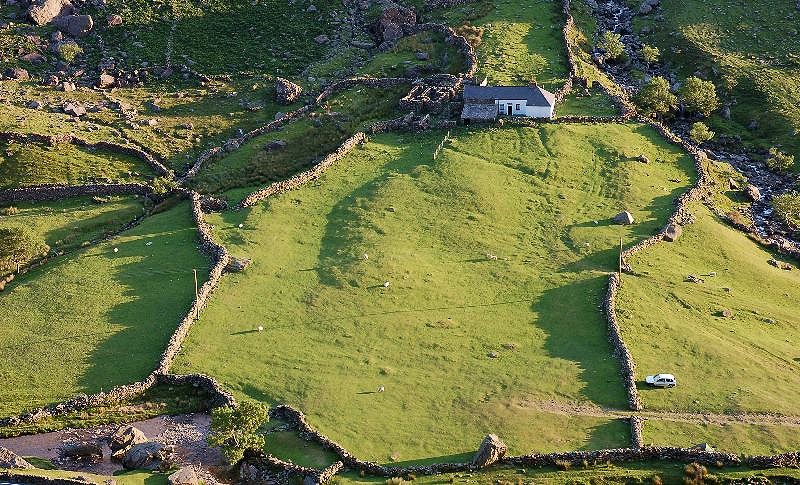
DIGITAL ISSUES
The biggest single issue in digital photography is concerned with manipulation of the image, and how far divorced the final image is from the original. Because of my creative background, I don't have a problem with this. I recall attending an Adobe course on Digital Photography in 1998, becoming a convert overnight, and began to spread the gospel. No more late hours working in the Darkroom. Out with the enlargers. I didn't get a camera immediately as they were still had issues at that time, but along with a PC, I also acquired a neg scanner. This was because of my art background, I was able to envision the creative potential the new technology offered, and that was just the beginning. To the same extent that there has been the ongoing debate of Digital v. Film, (chiefly concerned with resolution), of Darkroom v. the PC, of Colour v. B&W. And so the debate rumbles on.
However, the biggest single issue with digital photography is truth. Yet, what is truth? Did Leonardo depict all the figures in the Last Supper as we now see them? Did Monet paint his Waterlillies exactly as they were growing in his garden? Did Ansel Adams darken skies with filters and darkroom manipulation? And so the argument continues. However, the danger perceived with climbing is placing a climber on a route he hasn't climbed, or erasing a rope, so it looks like a solo climb. A few weeks ago one of the Sunday glossies sported an image of a young attractive female climber clinging precariously to an overhanging cliff by her fingernails. Very dramatic, but it wasn't real. She had been cloned from an indoor wall. The newspaper had done it for dramatic effect. When did newspapers ever prevent truth from getting in the way of a good story?
Therefore, the climbing photographer has a responsibility to both themselves, as well as the sport in which they are engrossed. However, there are no hard and fast rules to help in this issue, as there are no rules as to what makes a good photograph. It is the perogative of each individual photographer as to where that truth lies, and the viewer of the final presented image has the right to either accept or reject what they see. Each picture does not come with a health warning, but should be accepted for what it is. In some instances we can guess at what manipulation has occurred, but as in an Art Gallery, or an image viewed in a magazine, we often have no prior information about any given work of art unless the artist/gallery chooses to provide such information. Besides, does such information inform us any better, are we more aware and educated or do we finally accept the image for what it is?
A truly great photograph will stand by itself, needing neither explanation nor excuses.
" I really believe there are things nobody would see if I didn't photograph them."
Diane Arbus
DIGITAL WORKFLOW
A Digital Workflow process is an essential method of working that must be standardised in order to obtain consistent results, especially if you are serious about photography. There are detailed methods outlined on the Luminous Landscape website among others (see below), but a good basic outline should consider the following:
1. Saving you digital negatives (preferably on a CD-R disc) so you always have an original image without any editing or loss of digital information. A contact sheet can also be included along with this
2. Configuring both Camera and PC to the right colour space (Adobe RGB or sRGB if mainly using the web) The PC Monitor might also require calibrating
3. Saving a working copy to the hard disc for manipulation. Files need to be organised so that they are easy to retrieve
4. Processing the RAW or J-peg file with suitable software & saving in TIFF format (Saving an image in J-peg format gradually degrades the image)
5. Resizing & Cropping of the image as necessary
6. Carry any Colour Correction if necessary
7. Tonal adjustment using layers as required including converting to B&W or tone adjustment with Curves/Levels
8. Selective enhancement or correction of the image and unwanted objects (now is the time to remove those annoying telegraph lines!)
9. Saving the manipulated image. This can be either Tiff or PSD to preserve layers for possible future manipulation
10. Sharpening. Flatten Layers first, but remember the differing different requirements for print or the web
All the above might sound very confusing but a lot of the processes can be automated and indeed some software is but a single click but that removes a lot of the control from the photographer. Find out what works for you.
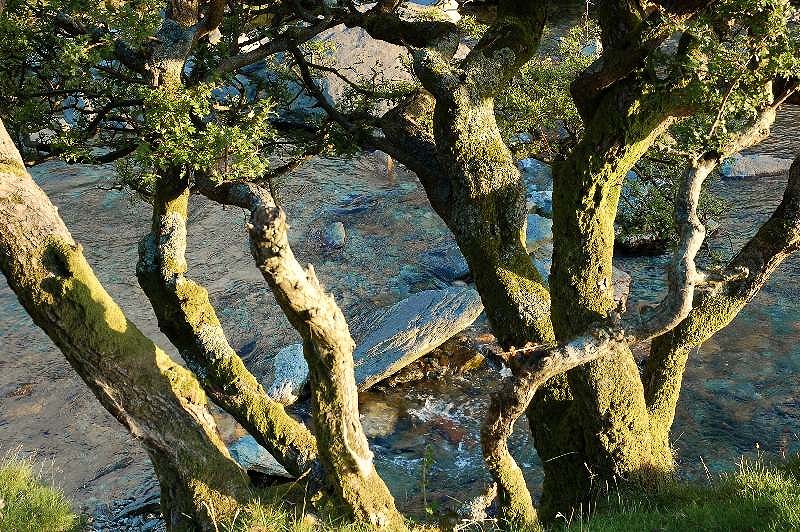
CONCLUSION Remember that the purpose behind most mountain photography is to return with images that capture that which is so special about climbing and the mountain environment. The empathy this excites within both photographer, and viewer of those pictures. We can't replicate the moment or experience without actually being there, but a good photograph might be close, and the best photographs, very close indeed.
USEFUL WEBSITES
www.adobe.com
www.luminous-landscape.com
www.cubbyimages.co.uk
www.robgalbraith.com
www.normankoren.com
www.photostuff.co.uk
www.kelbysnotes.com
www.layersmagazine.com
www.mountainbooks.co.uk
www.dpreview.com
www.zonezero.com
FURTHER READING ON THE SUBJECT
Ansel Adams: Yosemite -The Seeing Eye & the Written Word 1979 Little, Brown & Co
Helmut Dumler & Willi Burkhardt: The High Mountains of the Alps 1993 Diadem Books
Scott Kelby: the Photoshop CS2 book for digital Photographers 2005 New Riders/Peachpit
Scott Kelby: the Photoshop Elements book for digital Photographers 2005 New Riders/Peachpit
Herbert Maeder: the Mountains of Switzerland 1968 George, Allen & Unwin Ltd
Galen Rowell: In the Throne Room of the Mountain Gods 1977 Sierra Books
Gordon Stainforth: Eyes to the Hills 1991 Constable & Co Ltd
Vittorio Sella: Summit - the Years 1879-1909 1999 Aperture
Heinz Zak: Rock Stars 1995 Rudolf Rother GmbH
About My Photography
Whenever I have moved house a new darkroom was always required up until now that is when I have gone totally digital. I started off using Pentax but changed to Nikon. I studied Photography at college as part of a Graphics BA and have always had a camera in my hand from then. To be really good at some aspect of Photography one has to devote time, thought and effort to that skill, and never stop looking at what others are doing in that discipline. I always see other work that I admire and wish I had their vision. The first photographer I remember was a spread by Don McCullin in the Sunday Times during the Vietnam War in about '67/8. He achieved real impact with black and white images. The other early influence was John Cleare's 'Rockclimbers in Action in Snowdonia' also in black and white. I recall seeing some ariel photographs by Bradford Washburn taken on a large-format camera of the Matterhorn which displayed incredible detail of the mountain. Sam Haskins made an impact because he over exposed film and you first realised you could break the rules. At present I admire the work of Colin Prior for his Panoramic Landscapes on large format cameras and 'Cubby' for his action pictures.
You can view Sean Kelly's portfolio at www.ukclimbing.com/photos



Comments